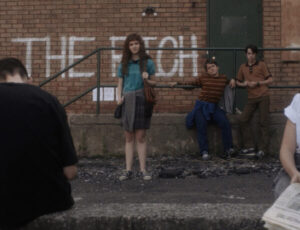In the prison system, punishment and rehabilitation go hand in hand. It’s hard not to picture convicted criminals as dangerous people who cannot change. This bad-to-the-bone image strips prisoners of their humanity. Lisa R. Cohen’s film Serving Life (2011), a documentary originally produced for the Oprah Winfrey Network, smashes these stereotypes by introducing audiences to a number of prisoners who volunteer as care workers in the hospice at Louisiana State Prison, aka Angola.
Angola is the largest maximum-security prison in the United States, and used to be one of the most violent. The violence has dropped by 75% over the past several years, largely due to the changes brought in by Burl Cain, Angola Prison’s Warden. Cain, a religious man, believes that by appealing to the soul, prisoners can be truly rehabilitated and saved. Although I personally believe he subscribes to a very simplistic view of criminality (crime as stemming from selfishness), his rules have clearly made an impact on the prison community at large. The program which this film focuses on, and that he talks up the most, is the hospice program. Angola’s prison population is aging, with the vast majority serving life sentences. These men will eventually become sick and require end of life care. Cain wants them to be tended to compassionately, and so he turns to the prison population to search for volunteers who will provide companionship and care to their fellow prisoners at the end of their lives.
The film follows four men who are newly enrolled in the hospice program. We get to know each personally, all of whom are amicable, model prisoners with different backgrounds and criminal convictions. Charles Rodgers (aka Boston) is a headstrong young father being held for armed robbery. His friendly demeanor and easy smile helps him bond with patients, but dealing with open wounds and witnessing deaths first hand take their toll. Another caretaker, Ronald Ratliff, is serving a life sentence under the controversial 3 strikes law. For me this was one of the more fascinating elements of the film: seeing the wide variety of crimes that somehow equal out to the same or similar sentences. For instance, all 3 of Ratliff’s strikes have to do with drug sale or possession. It’s hard to understand how his crimes can be viewed as equal to those of the serial rapists and murderers who share the same sentence.
The work in the hospice is both emotionally and physically draining. Care workers need to bathe their patients and deal with everything from diapers to bed sores. Not everyone lasts long in the program. However, the positive impacts on both the patients and the workers are obvious. The leader of the hospice volunteers is a man serving time for first-degree murder. Formerly on death row, he found himself wondering what to do when he was dropped down to a life sentence. His work in the hospice helped him find purpose.
The film at times feels like it’s shooting this situation through rose-coloured glasses. It does a wonderful job of humanizing the inmates we meet, however, it’s too happy go lucky. This is a prison after all. Perhaps the film could have made a stronger statement by contrasting these positive changes with more information about the prison’s brutal past. Daily life also looks like a cakewalk for these men, something that’s hard to believe when in reality the majority of them are worked to the bone from dusk to dawn. Although the film’s positive spirit comes off as overly sweet, this doesn’t completely spoil the message of prisoners’ capacity for humane care and their ability to find redemption by helping others.







